The difference between free forging and die forging
Free forging is a processing method in which the heated metal blank is placed between the upper and lower anvil iron of the forging equipment, and the impact force or pressure is applied to make it produce plastic deformation, so as to obtain the required forgings. During the forging process, except for the part of the surface that is in contact with the upper and lower anvil iron or other auxiliary tools, the blank is a free surface, and the deformation is not restricted, so it is called free forging.
Free forging can usually be divided into manual free forging and machine free forging. Manual free forging mainly relies on manpower to use simple tools to forge the blank, so as to change the shape and size of the blank to obtain the required forging. Manual forging has low productivity, high labor intensity and small hammering force, which has been replaced by machine forging in modern industrial production. Machine free forging mainly relies on special free forging equipment and special tools to forge the blank, change the shape and size of the blank, so as to obtain the required forgings. The advantages of free forging are: simple tools, strong versatility, flexibility, suitable for single and small batches of forgings, especially the production of extra-large forgings. The disadvantages of free forging are: low forging accuracy, large processing allowance, low production efficiency and high labor intensity.
Die forging is a kind of processing method in which the heated blank is placed in the die boring of forging die, and the blank is deformed under the action of forging pressure. When the blank is deformed, the flow of the metal is limited and guided by the impression, so that the forging is consistent with the shape of the impression.
Compared with free forging, the advantages of die forging are:
1)Because there is a impression to guide the flow of metal, the shape of the forging can be more complex;
2) The forging flow line inside the forging is distributed according to the forging profile, thereby improving the mechanical properties and service life of the parts;
3) Forging surface smooth, high dimensional accuracy, saving materials and cutting processing hours;
4) High productivity;
5) Simple operation, easy to realize mechanization.
However, because the die forging is integral forming, and when the metal flows,it produces great friction resistance with the impression,so the required equipment tonnage is large and the equipment cost is high. The forging process is complex, the manufacturing cycle is long, and the cost is high, so the forging is only suitable for batch or mass production of medium and small forgings. However, with the rapid progress of computer aided design - manufacturing (CAD/CAM) technology, the manufacturing cycle of forging dies will be greatly shortened.



 Phone
Phone Send Email
Send Email











